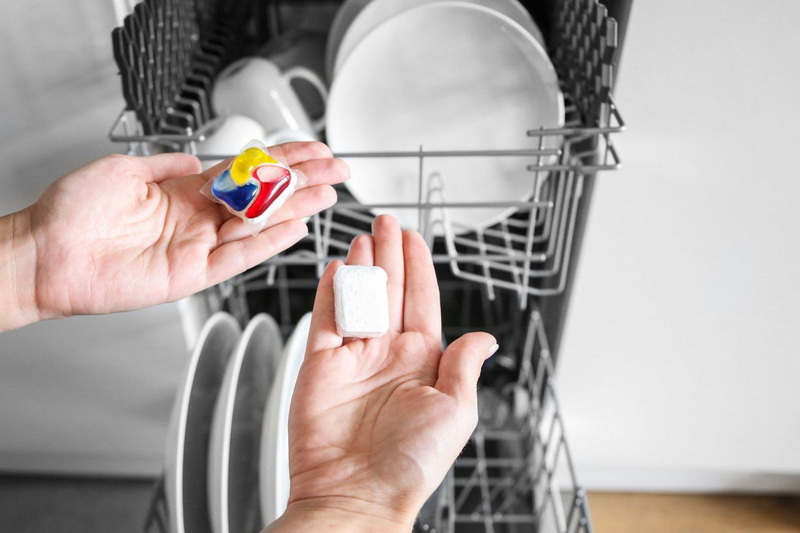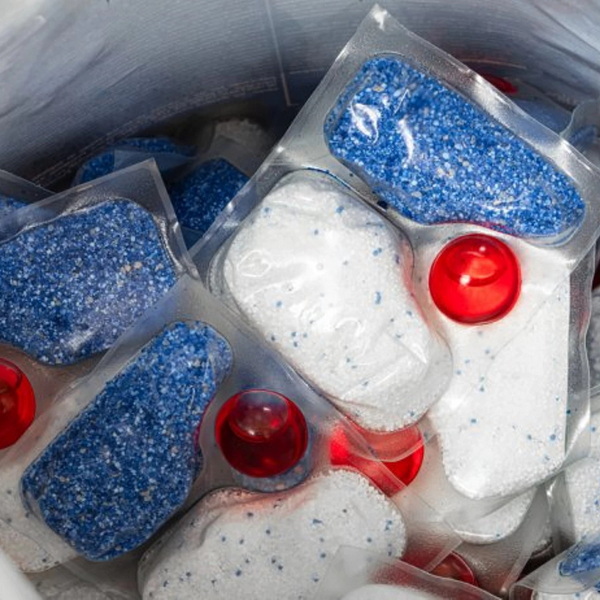Dongguan UFine Daily Chemical Co.,Ltd.
- All
- Product Name
- Product Keyword
- Product Model
- Product Summary
- Product Description
- Multi Field Search
Views: 222 Author: Tomorrow Publish Time: 11-07-2025 Origin: Site











Content Menu
● What Are Pod Dishwasher Detergents?
● Performance and Cleaning Power
● User Experience and Convenience
● Effectiveness Across Load Types
● User Behavior and Best Practices
● Choosing the Right Format for Your Needs
● FAQ
>> 1. Are dishwasher pods safer than tablets for children?
>> 2. Do dishwasher pods dissolve in all machines?
>> 3. Can I use two pods for a large load?
>> 4. How does water hardness affect pod performance?
>> 5. Are there eco-friendly pod options?
Dishwasher detergents come in several formats, each marketed with its own set of advantages. Pod dishwasher detergents, sometimes called dishwasher pods or packs, have grown in popularity due to their convenience and perceived consistency. This article examines whether pods are better compared to other formats, including tablets, powders, and gels. It covers cleaning performance, user experience, cost considerations, environmental impact, and practical tips for choosing and using pod detergents. By the end, readers should have a clear understanding of when pods might be the superior option and when other formats deserve consideration.

Pod dishwasher detergents are pre-measured packets containing concentrated detergent along with other additives such as rinse aids or water softeners. Each pod is designed to dissolve completely in the dishwasher's wash cycle, releasing its cleaning agents in a controlled manner. Pods aim to reduce handling mess and ensure a uniform dose for each load.
- Consistent dosing: Pods provide a single, pre-measured amount, which helps prevent under- or over-dosing. This consistency can lead to more reliable cleaning across a range of residues, from light everyday grime to baked-on dishes.
- Formulation advantages: Many pods combine multiple active ingredients—such as surfactants, enzymes, and stain fighters—in a single capsule. This can improve grease-cutting capability and efficiency on tough stains.
- Compatibility with dishwashers: Pods are designed to work across standard dishwasher models, assuming correct dosage and appropriate cycle settings. Some users report that pods shine in machines with effective water distribution and proper loading technique.
- Mess-free handling: Pods minimize direct contact with detergent, reducing skin irritation and messy spills. This is especially appreciated in households with children or sensitive skin.
- Storage and dosing simplicity: Pods are easy to store and require no measuring cups. This simplifies operation for first-time users and reduces the likelihood of accidental overuse.
- Risk of misusage: Although rare, pods can fail to dissolve if placed in the wrong compartment or if the dishwasher is overloaded, leading to residue on dishes. Ensuring the pod sits in the detergent dispenser and not in the bottom of the drum helps mitigate this risk.
- Per-load cost: Pods are often priced higher per load than powders or gels. The premium reflects convenience and the integrated formula design.
- Long-term value: For households with frequent loads and higher cycles, the convenience factor can translate into time savings, potentially offsetting higher per-load costs. Bulk purchasing may help reduce unit price.
- Waste and packaging: Pods typically come in sealed packaging designed to protect contents. The environmental footprint includes packaging materials and plastic wrappers, which may influence decisions for eco-conscious buyers.
- Packaging and plastics: Pods are usually encased in water-soluble film and a secondary outer packaging. Although water-soluble packaging reduces some waste, the overall packaging volume remains a consideration.
- Detergent formulation: Modern pod formulations often use biodegradable surfactants and reduced phosphates, aligning with stricter environmental standards in many regions. However, some settings still prefer concentrated powders due to perceived lower packaging waste.
- Light loads and high-efficiency machines: Pods perform very well in most daily dishwasher scenarios, delivering clean dishes with minimal pre-rinsing.
- Heavily soiled cookware: Enzyme-based pods can still tackle common food residues, though for heavy grease and burnt-on foods, a more robust formulation or supplementary pre-soak might be beneficial.
- Hard water conditions: Water hardness can affect detergent performance. Many pod formulas include water-softening agents to help counteract mineral deposits, but users in very hard water areas may need to adjust detergents or add rinse aids.

- Correct placement: Always place the pod in the detergent dispenser, not in the bottom of the dishwasher. Ensure the dispenser door closes properly for complete dissolution.
- Load optimization: Do not overload the dishwasher. Adequate spacing allows water to circulate and the pod to dissolve effectively.
- Water temperature and cycles: Use a wash cycle appropriate for the load. Some pods work best in standard or optimized eco cycles; very short cycles may not allow full dissolution.
- Maintenance: Regularly check spray arms for clogs and ensure filters are clean. Proper machine maintenance complements detergent performance.
- Child safety: Store pods out of reach of children and follow manufacturer warnings. The bright packaging and the appearance of pods can attract curious hands.
- Skin and eye contact: While pod detergents are designed to minimize exposure, accidental contact with skin or eyes should be rinsed immediately. Follow safety guidelines on the product label.
- Ingestion risk: Pod detergents are not intended for ingestion. If a pod is swallowed, seek medical attention promptly or contact poison control.
- Tablets: Similar in convenience, tablets may offer slightly more customization in cost and potency. Some users appreciate the flexibility to adjust dose for smaller loads.
- Powders: Powder detergents can be more economical per load and may offer better performance for very dirty cookware or hard water environments when used with proper dosing.
- Gels: Gel detergents can be convenient for quick washes and often dissolve easily, but they may leave streaks on glassware if not used correctly.
- Frequency and load type: For households with a mix of light and heavy loads, tablets or powders may offer a balance of cost and performance. For busy families seeking convenience, pods are a strong option.
- Water hardness: In hard water areas, detergents with built-in water-softening agents or the addition of a rinse aid can improve outcomes, regardless of format.
- Environmental priorities: If packaging waste is a primary concern, compare the total environmental footprint, including packaging, production processes, and waste disposal for each format.
- Pre-rinse habits: Modern detergents are designed to handle typical residue. Pre-rinsing is rarely necessary with a quality detergent and proper cycle settings.
- Detergent freshness: Keep detergents in a cool, dry place away from direct sunlight to maintain potency. Pods should remain sealed until use to prevent moisture exposure.
- Regular testing: If you notice a decline in performance, try a different format or brand to see if results improve. Variation between machines and water conditions can affect outcomes.
Pod dishwasher detergents offer a compelling blend of convenience, consistency, and mess-free handling. They work well for a broad range of loads and machines, particularly in households that value ease of use and want to ensure a uniform dose per wash. However, pods often come at a higher per-load cost and may not be the optimal choice in very hard water areas or for users seeking maximum control over dosing. When choosing between pods and other formats, consider load type, water hardness, budget, and environmental priorities. Pods can be the better option for busy households seeking consistent results with minimal effort, while powders or tablets may yield better value for large or heavily soiled loads.

Pods pose ingestion and poisoning risks if accessed by children. Store them securely and follow packaging safety guidelines. If a pod is ingested or if there is contact with eyes or skin, seek medical advice promptly.
Most modern dishwashers are compatible with pods, but dissolution can be affected by loading method, cycle duration, and water temperature. Place the pod in the dispenser and use an appropriate cycle to ensure complete dissolution.
It is generally not recommended because pods are pre-measured for a standard load. Using more than one pod can lead to oversaturation and residue. For very large or dirty loads, consider a higher-potency tablet or a powder that allows adjustable dosing.
Hard water can reduce detergent efficiency by forming mineral deposits. Many pods include water-softening agents, but in very hard water areas, using a rinse aid or a water-softening deteregent combination can improve results.
Yes, some pod formulations prioritize biodegradable surfactants, phosphate-free chemistry, and reduced packaging. Compare labels for environmental certifications and ingredient lists to find the most eco-friendly option.